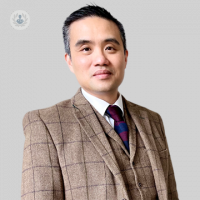Returning to sports after a hip replacement
Written by:Nowadays, hip replacement recovery is faster than ever. Of course, for many people the big milestone is when you can get back to playing sports again. In this article, double board-certified consultant orthopaedic surgeon Professor Paul Lee offers his recommendations on how long to allow yourself to recover before returning to different sports, and how to get back into action safely.

Different sports can put different kinds of strain on the body. It’s important to follow the advice from your surgeon on how long to wait before going back to your favourite sport and how to get back into it safely. Here are some general guidelines on some of the most common sports patients in the UK play:
Golf
How long to wait: Refrain from all golf including the driving range for the first six weeks. This is because twisting the hip joint at this early stage could cause you pain and hinder recovery. Unless you have had the S.P.A.I.R.E. hip replacement, you need to discuss with your surgeon about the specific movements to avoid.
Getting back into it safely: Start off with putting, but leave the big irons for at least six months. There is a huge amount of rotational force at the hips with each drive, so keep your legs wide apart and with the foot slightly externally rotated to take the pressure off the hips.
Swimming
How long to wait: Avoid public swimming pools for the first six weeks while your surgical wound is still healing and to reduce the risk of infection.
Getting back into it: After six weeks you should be able to return to swimming without any problem. Swimming is an excellent way to exercise all of the muscles in your body, and the support of the water helps with safe, fluid movement.
Hiking
How long to wait: You can go on gentle walks immediately after surgery, but hiking on uneven ground isn’t recommended for at least three months until your muscles settle down and get used to your new hip.
Getting back into it: It’s a good idea to use walking poles throughout your recovery to provide extra support.
Running
How long to wait: You can run as soon as you feel you have fully recovered. It will wear out your hip over time, but if running is the sport you enjoy it is an individual choice as to whether you continue to run.
Getting back into it: Try to keep you runs to under 10km at a time and stop if you feel uncomfortable. Running is a high-impact sport which puts a lot of pressure on the joints of your body.
Skiing
How long to wait: You can get back to skiing as soon as you feel you have fully recovered and able to achieve at least 80% of a single leg squat. From the hip replacement point of view it is relatively safe, as long as you don’t “wipe out”.
Getting back into it: Start gently and avoid icy conditions, minimising deep hip flexion movements. Try to avoid the moguls and steep declines. It would be a good idea to use some assisted device such as Ski-mojo to reduce the overall stress to the body.
Tennis
How long to wait: You can get back to tennis as soon as you feel you have fully recovered and able to achieve at least 90% of a single leg squat.
Getting back into it: Start gently and avoid wet conditions, be careful and try not to lunge for the ball if possible. Keep your legs wide apart to ensure stability.
Football
How long to wait: You can play as soon as you feel you have fully recovered. Be sensible – remember football is not a contact sport.
Getting back into it: Try to have short breaks and keep intervals for about 10-15 minutes, and stop if you feel uncomfortable. Five-a-side indoor football may be a better option as the environment is better controlled.


